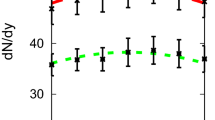Summary
A simple annihilation model leads to a set of predictions for pion distributions with marked differences with those found in proton-proton collisions. In particular most pions should be produced with low (<2) centre-of-mass rapidity and their mean multiplicity should increase proportionally to the centre-of-mass energy.
Riassunto
Un semplice modello di annichilamento porta ad un insieme di previsioni per le distribuzioni dei pioni, con notevoli differenze da quelle trovate nelle collisioni protoneprotone. In particolare, molti pioni dovrebbero essere prodotti con una bassa (<2) rapidità del centro di massa, e la loro molteplicità media dovrebbe crescere proportionalmente all’energia del centro di massa.
Реэюме
Простая модель аннигиляции даёт систему предскаэаний для распре-делений пионов, которые эаметно отличаются от распределений, полученных в соударениях протона с протоном. В частности, больщинство пионов должно рождаться с малой скоротью центра масс (< 2) и средняя множественность пионов должна воэрастать пропорционально знергии центра масс.
Similar content being viewed by others
References
R. Armenteros andB. French:High-Energy Physics, Vol.4, edited byE. H. S. Burhop (New York, 1969), p. 237.
D. Horn:Phys. Reports, to be published.
T. Fields, Y. Oren, D. S. Rhines andT. Whitmore: ANL/HEP 7223 (1972).
D. B. Smith: UCRL-20632 (1971);R. Panvini et al.: Brookhaven preprint (1972); Soviet French Collaboration: preprint (1972).
E. Berger, M. Jacob andR. Slansky:Correlations in high-energy production processes, to be published inPhys. Rev.
E. Flaminio, J. D. Hansen, D. R. O. Morrison andN. Tovey: CERN/HERA 70-3;G. Alexander, I. Bar-Nir, S. Dagan, A. Fridman, G. Gidal, J. Grunhaus, A. Levy andY. Oren:Nucl. Phys.,23 B, 557 (1970).
M. Jacob andR. Slansky:Phys. Lett.,37 B, 408 (1971);Phys. Rev. D,5, 1847 (1972).
W. Burdett et al.: Vanderbilt-Brookhaven preprint (1972).
L. G. Ratner, R. J. Ellis, G. Vannini, B. A. Babcock, A. D. Krisch andJ. B. Roberts:Phys. Rev. Lett.,27, 68 (1971).
Comparingσ A with a power ofp L (rather than ofs) corresponds to the common usage (see ref. (6)). For the available p-bp data and the choice of variables orp L makes a significant difference and √sσ A is much less constant than √p LσA. Since in annihilation processes all the available energys is converted into pion production we believe that the choice ofs is more natural. We note that had we used (p c.m.)2 σ A instead ofsσ A we would have obtained a function which would have had roughly the same variation over the region of interest.
Recently there have been several papers,e.g.,H. Goldberg: Northeastern preprint (1972);R. F. Amann: Syracuse preprint SU 4203 (1972); which have used rather successfully models of essentially the multibaryon Regge variety to explain many features of annihilation data. The arguments presented here suggest that at somewhat higher energies such models will be inadequate and in particular eq. (2) will hold.
Author information
Authors and Affiliations
Additional information
To speed up publication, the authors of this paper have agreed to not receive the proofs for correction.
Rights and permissions
About this article
Cite this article
Jacob, M., Nussinov, S. Pion production in high-energy proton-antiproton annihilation. Nuov Cim A 14, 335–342 (1973). https://doi.org/10.1007/BF02728957
Received:
Published:
Issue Date:
DOI: https://doi.org/10.1007/BF02728957




